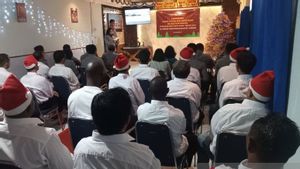JAKARTA - Elon Musk's long-awaited trial flight for the Starship program worth US$3 billion (Rp44 trillion) finally ended in a dramatic explosion during an increase. After launching from Boca Chica, Texas, engineers called the Starship flight "surprisingly" despite the "rapidly unscheduled explosion" - an elegant term for an explosion.
The super heavy transit system was launched April 21 at around 9:30 a.m. US time (2:29 p.m. BST time), with 33 engines pushing structures of more than five million pounds into the sky. However, after just three minutes, the rocket exploded when the two parts could not be separated as planned.
Starship liftoff in slow motion pic.twitter.com/KqHjqwP88Z
— Elon Musk (@elonmusk) April 22, 2023
Then, why did SpaceX's Starship explode and is this mission still a success?
After a highly anticipated launch, Starship had problems with its decoupling mechanism. This caused the rocket to start rotating after leaving the ground and then exploded into flames a few minutes later. SpaceX engineers also believe at least three of the 33 ship's engines were "dead" during the launch.
However, despite the "rapidly unscheduled explosion" on Starship, the team still found the launch "extraordinary." The main goal of the launch was to collect data for the next test flight, which was obtained despite the explosion.
As a result, SpaceX engineers still consider the launch a success and will "examine the data" for the next time. SpaceX tweeted, "In a test like this, success is obtained from what we learned, and today's test will help us improve Starship's reliability as SpaceX seeks to create life on various planets."
"You never know what will happen," said one insiyur quoted by the Daily Mail. He claims that Starship doesn't disappoint with exciting endings during testing.
Elon Musk also congratulated his team on SpaceX. Musk tweeted that they had "learned a lot" for future launches. During the Twitter Spaces event on Sunday, April 22, he also claimed that success was getting away from the launch pad without exploding.
SpaceX's Starship that exploded into a fireball during its first orbital launch was considered not a total failure. This happened when the bottom of the rocket - known as the Super Heavy Booster - could not be separated from the top of the rocket. The splitting mechanism was designed to allow the top of the Starship to venture into space on its own. It is understood that this process should have taken place just more than two minutes after the explosion.
However, even though Starship failed in its first test mission, the SpaceX team still considered it a success because they managed to get the data needed for further testing. They will review the data obtained during this mission to improve Starship's reliability in the future.
However, the failure to launch the first Starship shows how difficult the task SpaceX faces in developing rocket launch technology that can be used for space exploration and travel to other planets. However, this did not dampen the SpaceX team's enthusiasm to continue trying and innovating to advance rocket launch technology to the next level.
The English, Chinese, Japanese, Arabic, and French versions are automatically generated by the AI. So there may still be inaccuracies in translating, please always see Indonesian as our main language. (system supported by DigitalSiber.id)













